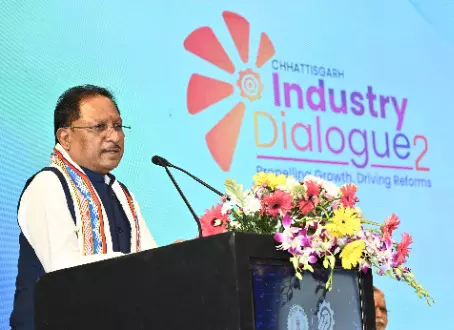Chhattisgarh receives Rs 1.25 lakh crore investment proposals in ‘Industry Dialogue 2’

Raipur: Chhattisgarh is rapidly emerging as one of India’s fastest-growing industrial hubs. Over the past one and a half years, the state has received investment proposals totalling more than Rs 6.75 lakh crore, reflecting a strong and growing confidence among investors. This progress was further reinforced at the 'Industry Dialogue 2' held in Raipur today, where new proposals worth Rs 1.25 lakh crore were finalized in the presence of Chhattisgarh Chief Minister Vishnu Deo Sai.
The strong interest from investors highlights the state’s growing importance in India's industrial landscape. Once known primarily for its forests and mineral resources, the state is now emerging as a hub of opportunity and innovation. Chhattisgarh Chief Minister Vishnu Deo Sai shared that even place like Bastar, once focused on security, are now turning into hubs of industry, technology, and jobs. This progress is a clear step toward realizing Prime Minister Narendra Modi’s vision of a ‘Developed India’.
The new investment proposals worth Rs 1.25 lakh crore is no longer limited to traditional mining areas, but is focused on future sectors like IT, semiconductors, healthcare, green energy and logistics.
“Chhattisgarh is no longer just a land of minerals, but a land of potential. We are bringing remote regions like Bastar into the mainstream of development. Investors today are getting stability, security, and swift decision-making,” the Chief Minister said while addressing the event. This shift in investor confidence is not limited to urban centers; it is also significantly growing in tribal regions like Bastar and Surguja.
The recently implemented Industrial Policy 2025 has played a crucial role in making Chhattisgarh a natural destination for investors. Key features of the policy include the Single Window System 2.0, over 350 reforms, fast-track land allotment, auto-approval mechanisms, and special incentives for women entrepreneurs, SC/STs, third gender, and rehabilitated former Naxalites. The state has effectively transitioned from ease to speed of doing business.
As part of this policy, Chhattisgarh has also announced its first Special Economic Zone (SEZ) near Raipur, with a focus on IT, pharmaceuticals, and electronics manufacturing. The SEZ will offer plug-and-play infrastructure, subsidized land, and rapid administrative clearances—designed to attract significant foreign direct investment and enhance the state’s export-oriented growth model.
A symbol of this transformation is the upcoming Rs 11,000 crore semiconductor unit and AI-powered data center park in Nava Raipur. The semiconductor facility, set up by Polymatech Electronics, will produce 10 billion chips annually by 2030. In parallel, RackBank Datacenters is establishing a 150 MW data center, expected to generate over 2,000 direct and indirect jobs. These projects aim to prepare Chhattisgarh’s youth for the Fourth Industrial Revolution.
The government has also given industrial status to the tourism sector, with targeted efforts to develop tribal regions such as Bastar and Surguja as heritage and eco-tourism hubs. Mega projects such as a 200-acre medical city and a 142-acre pharma hub in Nava Raipur are underway to boost healthcare infrastructure, employment, and sectoral investment.
To strengthen logistical infrastructure, the state cabinet approved the Chhattisgarh Logistics Policy 2025 on June 30. This policy aims to transform the state into a national logistics hub, with a special focus on tribal areas. In districts like Bastar and Surguja, the government plans to develop logistics parks, cold chains, transport centers, and air cargo facilities. Companies investing in these regions will receive 10% additional grants and up to 40% infrastructure support.
Once synonymous with Naxalism, Bastar is now scripting a new story of peace and progress. In the past 18 months, 435 hardcore Naxalites have been neutralized, 1,457 have surrendered, and 146 have been arrested. Through the Niyad Nellanar Yojana, remote villages are now connected with roads, electricity, education, and healthcare. Notably, Belkapalli village received electricity after 77 years, and roads have been constructed to Puverti, the native village of Naxal commander Hidma.
Bastar’s transformation extends to tourism as well. Dhoomdharas village was recognized by the United Nations as a “Best Tourism Village”, while Kanger Valley has been added to UNESCO’s tentative list. Local initiatives like homestay programs, cultural festivals, and the Bastar Olympics are providing both income and pride to tribal communities.
Chhattisgarh has also made significant leaps in infrastructure development. For the fiscal year 2025–26, the state has allocated Rs 9,500 crore for infrastructure, including Rs 2,000 crore for road construction. Major projects supported by the central government, such as the Urga–Katghora bypass, Raipur–Lakhnadoun Economic Corridor, and the Kharsia–Nava Raipur–Parmalaksa rail corridor, are progressing rapidly. With Rs 48,000 crore worth of railway projects and the modernization of Bilaspur, Ambikapur, and Jagdalpur airports, Chhattisgarh is expanding its multimodal connectivity at an unprecedented pace.
Importantly, the state’s ambition extends beyond infrastructure and investment. With a clear goal of achieving net-zero carbon emissions by 2070, Chhattisgarh is prioritizing green steel production, solar power expansion, and sustainable industrial zones.
It is noteworthy that since the implementation of the new industrial policy, companies across sectors have pledged over ₹5.5 lakh crore in investments. Of this, Rs 3.5 lakh crore is dedicated to power generation, including 12,000 MW of thermal, 12,000 MW of renewable, and 4,000 MW of atomic energy.
Chhattisgarh aims to increase its Gross State Domestic Product (GSDP) from Rs 5.68 lakh crore in 2024–25 to Rs 6.35 lakh crore by the end of the current fiscal year. To support this growth, the government has raised its capital expenditure from Rs 22,000 crore to Rs 26,000 crore, with a strong focus on infrastructure.
The state currently maintains a growth rate of 7.5%, which is above the national average, signaling Chhattisgarh’s firm and focused stride towards becoming a vital pillar of Viksit Bharat (Developed India).



